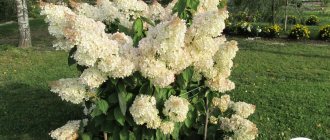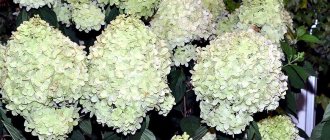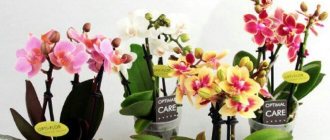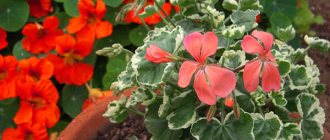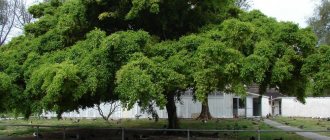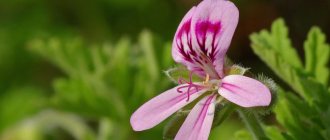Most types of mints (there are about 40 species and hybrids in total) are perennials with branched stems and simple aromatic leaves that can be pubescent. Various types and varieties of mint bloom from June to September with small, whitish or purple flowers collected in whorls or spike-shaped inflorescences.
- Origin of the name of the genus: Mint - Minta
- Cultivated species and varieties of mint for growing in gardens and pharmaceutical gardens Peppermint, cold mint or English mint, Mentha piperita
- Longleaf mint, Mentha longifolia
- Spearmint, Mentha spicata
- Round-leaved mint, or sweet mint, Mentha suaveolens
- Water mint, Mentha aquatica
Peppermint variety Grapefruit
Pepper
Peppermint or English mint was created by crossing wild species (mint arvensis and wild mint) in England in the 17th century. The name pepper is explained by the presence of a burning taste of the leaves of the plant.
A perennial herbaceous medicinal plant with a pleasant aroma. There are more than 100 types of mint.
Chocolate
Perennial herbaceous plant . A subspecies of peppermint. The leaves are simple, elongated with serrated edges of a purple hue. The leaves have a light chocolate aroma. The stem is tubular, 60-120 centimeters high. The inflorescences are white-pink, less often purple or lilac. Blooms from June to August. Loves lighted areas, but also grows in the shade. Requires watering. Grows everywhere. Used for making tea and desserts. It is an excellent antiseptic and tonic.
Coleus
Tropical ornamental plant of the Lamiaceae family. The plant can act as a shrub, subshrub and annual herbaceous plant. The stems are tetrahedral, erect, 50-80 centimeters high. The leaves are serrated, broadly oval in shape, very brightly colored, velvety with various patterns of white-pink-green, bright red, dark brown, purple, violet. The flowers are located at the top of the plant in the shape of a complex spike. Coleus love bright light and plenty of watering with soft, warm water. They grow in countries with tropical climates. Widely used in medicine and as decoration for flower beds.
Mexican
A perennial plant with a pleasant spicy aroma of mint and anise. The stems reach a height of up to 1.5 meters. The leaves are ordinary oblong. The flowers are candle shaped. They come in white, violet and lilac colors. Flowering period
from mid-June to late autumn.
Curly
A perennial herbaceous hybrid plant with a pungent odor. The stem is densely leafy, with a height of 30 to 100 centimeters. The leaves are sessile on short petioles, curly, ovate, pubescent on both sides. The flowers are small, collected in false whorls, pink-purple in color. Flowering period from late June to late September. Grows in Ukraine and Crimea.
Growing mint
The simplest of all perennials, the natural species is meadow mint - a malicious but aromatic weed. The main thing in growing mint is to plant it immediately in the right place: for planting, choose a light (possibly in partial shade) area with loose and fertile soil. Water in hot weather and feed along with other garden crops.
Propagating mint is easy too! segments of rhizomes, rooted stolons and just seeds. Seedlings with a piece of the root system and stolons will take root at almost any time of the season. Just don't forget to water.
Mint stolons that can be used for rooting. It is because of their presence that mint often turns from a pleasant aromatic guest into a tough aggressor, which has to be monitored and limited all the time.
Room
There are several popular varieties of indoor mint. It is grown at home as an unusual flower. Some varieties can be freely used for culinary purposes.
Prayer tree
Perennial houseplant in the form of a shrub. Evergreen. The stem is thin, well branched, reaching a length of 1 meter. The leaves are small, pubescent, with a subtle pleasant scent. The edges of the leaves are carved. The flowers are ordinary purple in color, collected in inflorescences. The plant is light-loving. At room temperature it blooms all year round.
Scandinavian ivy
Indoor herbaceous plant
with lodging shoots. The stem is creeping. Reaches 1 meter in length. The leaves are rounded at the edges, jagged, green in color with a shiny tint. Not picky, grows in any climatic conditions.
Plectranthus Ertendahl
The houseplant is exclusively decorative in the form of a subshrub. Stems are erect and up to 1 meter high. The leaves are velvety bright green on one side and purple on the other. Blooms profusely. The flowers are collected in white false whorls.
Beneficial features
The plant is grown not for its beautiful appearance or aroma, but for the benefits it brings to humans.
Benefit:
- helps get rid of inflammation of the respiratory tract;
- is an antispasmodic and antiseptic;
- helps in treating colds;
- reduces blood pressure levels;
- strengthens vision;
- has an analgesic effect;
- calms, reducing the level of anxiety and panic;
- helps to sleep;
- helps with angina pectoris;
- relieves pain in the stomach and intestines;
- has a choleretic effect;
- treats constipation and flatulence;
- relieves headaches;
- improves appetite and much more.
There is a lot of talk about the benefits of this plant. In its pure form, mint is useful. In addition, it is used as a flavorful additive to bitter mixtures and medicines.
It is undesirable to use:
- children under 3 years old;
- patients with hypotension;
- people with individual intolerance;
- mothers during lactation.
The use of mint causes infertility and varicose veins, so you should consult your doctor before using it.
Field
A perennial medicinal fragrant plant with a long creeping rhizome. The single, pubescent stem is branched and erect, from 15 to 45 centimeters in length. The leaves are petiolate, oval, finely toothed along the edges. The flowers are small
pink-violet or lilac. Blooms all summer until late autumn. It grows everywhere.
Here you will find a selection of 100 wild and meadow flowers with photos and descriptions
https://woman-l.ru/100-polevyx-cvetov/
Peppermint (mentha piperita) - what kind of plant is it?
Peppermint belongs to the Lamiaceae family. It is a perennial and reaches a height of up to 1 m. The description of mint says that the plant has:
- the root system consists of many thin branches. The roots are located shallow in the soil in a horizontal position;
- a central trunk with opposite lateral branches of a tetrahedral type, the apex is a complex spike-shaped inflorescence. Shoots begin to grow from the base of the stem;
- The foliage is simple dark green in varying sizes. On the main branches and trunk they are large, on additional branches they are smaller. The leaves have short petioles and sharp teeth; pinpoint glands and sparse hairs are visible on the blades.
Peppermint is a well-known crop
What mint is is familiar to everyone, but many find it difficult to answer what its fruits look like. These are reddish-brown nuts with one seed.
For your information! The plant appeared as a result of crossing garden and water varieties. It has high melliferous qualities, which is valued by modern beekeepers.
Blooming mint attracts hundreds of bees
Medicinal properties, harm and benefits of use
Mentha Piperita translated means “peppermint”. Among the common names, the most famous include cold mint or English mint, cold mint. The beneficial qualities of the plant are associated with the following actions:
- local anesthesia. Menthol activates receptors on the skin that are responsible for the perception of cold, causing a slight tingling sensation and coolness. Small vessels located in the upper layers of the skin respond to the receptor reaction. They narrow, reducing the rate of blood circulation and suppressing painful sensations;
- an increase in the lumen of blood vessels occurs simultaneously with a narrowing of the skin capillaries. The expansion leads to a decrease in blood pressure levels and relief of heart pain;
- normalization of the gastrointestinal tract. Internal use of medicinal herbs provokes irritation of the mucous membranes of the stomach and intestines, accelerating digestion processes. The antiseptic effect additionally suppresses the activity of pathogenic microflora in the intestines and activates the work of the gastrointestinal glands.
Note! Cosmetologists know everything about mint, as the plant moisturizes, nourishes and heals the skin, and helps improve the condition of the hair. It is used to produce tonics, lotions, and as a basis for compresses and lotions.
To treat seborrhea, shampoos, masks and rinses with mint extract are used.
Peppermint essential oil helps cope with many skin ailments and blemishes.
Constant use of peppermint is undesirable; its excessive amount leads to heartburn; over time, the body stops responding to its active components due to addiction. Possible harm from the medicinal plant:
- with constant use of mint tea for insomnia, it quickly stops working;
- can greatly reduce blood pressure levels;
- In children, the plant provokes allergic reactions.
Important! Regular use of mint tea drinks can cause problems with sexual desire in men. Deviation is associated with a calming effect
Contraindications to the use of the plant include allergies to the plant, cardiovascular diseases, stomach and duodenal ulcers.
Other uses for mint
Peppermint leaves are used in cooking. A small amount of the plant helps:
- add fresh notes to familiar sauces;
- improve the taste of dishes prepared from poultry and lamb;
- emphasize the aroma of cheese and vegetable soups.
Note! Mint can be combined with peas, cabbage, carrots, leeks
Mint tea should be drunk 1 cup per day
The plant can be used as a fumigator, since many insects cannot tolerate its aroma. When planting bushes in your garden plot, you can get rid of unwanted guests in the form of cockroaches, moths and flies. Peppermint aromatic oils are used to get rid of unpleasant odors and in the fight against migraines. Many perfume products contain lines with its scent: Armani, Guerlain, etc.
Sadovaya
Perennial herbaceous plant. The stem is annual, tetrahedral, 30 to 100 centimeters high. The leaves are oblong, ovate with pointed tips, smooth above, pubescent below. The flowers are small, purple in color. Flowering period from July to late summer. Grows in the south and southwest of Russia.
Mint for women and men
The benefits of mint for women have been tested and confirmed by many generations of women who have used the analgesic and sedative properties of this herb:
- to relieve pain during menstruation;
- to relieve symptoms of menopause;
- to reduce the manifestations of toxicosis during pregnancy;
- to reduce body hair growth.
Modern women have at their disposal an extensive list of medications for these purposes, but medicinal mint still does not lose popularity among the fair sex - after all, a natural remedy is always healthier than a synthetic one. In addition, this herb has become actively used by those who want to lose weight - since mint tea, due to its high content of essential oils, dulls the appetite and is not harmful to the female body even with constant use, it can be drunk generously while on a diet.
Another open question related to mint is its harm to men. There is an opinion that the use of this herb, affecting the level of male hormones, reduces libido, which the stronger sex usually fears like fire. However, it can be argued that the harm from mint for men is at least greatly exaggerated: some specific effects can only be noticed with abundant and systematic consumption of this herb and its derivatives. The only exception is when trying to wash other, more delicate areas with mint anti-dandruff shampoo. In this case, the effect is felt with lightning speed.
Lemon
Herbaceous perennial plant. The stem is erect and very branched. Stem height is from 30 to 125 centimeters. The leaves are ovate along the edge, coarsely toothed, opposite, petiolate. The flowers are small , inconspicuous, less often yellow or pink. They are collected in a corolla of 6-12 pieces. Flowering period from July to August. Grows in Ukraine and Moldova.
Origin of the name of the genus: Mint - Minta
The name of the genus Mint originates from the name of the nymph of the Cokytos River Minta (or Mintha, also Menta). The Minti Mountains in Triphylia in southern Elis are also named after her. Legend has it that Minta was the concubine of Hades, who abandoned her and made Persephone, daughter of Demeter, the goddess of fertility, his wife. But Minta did not want to give up, scolded and complained about her rival, for which she was trampled by Demeter, who loved her daughter very much. At the site of the death of the nymph, mint grew. By the way, the Greeks used mint in funeral rites.
Flea
perennial herbaceous plant
family Lamiaceae.
The stem is erect, branched, 20-60 centimeters high. The leaves are oblong, elliptical, wedge-shaped at the base, serrated along the edge. The flowers are small , collected in thick spherical rings, the corolla is pink-purple with a white tube. Blooms in July-August. It grows in floodplain meadows, along river banks in the western regions of Ukraine, in the south of the Caucasus, and in Central Asia.
What medicinal properties does it have?
Mint is widely used in folk medicine, cooking, and cosmetology. It can have the following effects :
- painkillers;
- vasodilators;
- anti-inflammatory;
- antiseptic.
Mint is very beneficial for the body, helps in the fight against various ailments.
Mint is a medicinal plant, it should be collected when the plant has gained color. Shoots, leaves, and flowers are used to make the drug. Mint is used to treat the following diseases :
- asthma;
- respiratory tract diseases;
- heart diseases;
- gynecological diseases;
- cardiovascular;
- liver;
- gallbladder.
Drops, mixtures, ointments, and tablets are made based on the plant . Essential oil is also added to toothpaste.
Before using a drug made from mint, you should consult your doctor to avoid side effects.
There are many types of mint in the vast world that have many beneficial properties. They are also widely used in the field of medicine . If this medicinal plant grows on the site, it can serve as a home first aid kit.
Feline
A perennial plant with a light lemon aroma. The stem, spreading along the soil, is tetrahedral, green, and has a strong, peculiar odor that attracts cats. Stem height is 40-100 centimeters. The leaves are velvety, green and jagged along the edges. The flowers are small, funnel-shaped, collected in long inflorescences of white color with purple specks. Flowering period June-July. It grows everywhere.
Varieties for home
Types of plants that can be grown at home on windowsills or in greenhouses.
Home (Plectranthus or Spurflower)
The indoor plant is represented by several species, but all of them have strongly branching stems and closely growing leaves of light or dark green color. The leaf blades are oval, with carved edges. During the flowering period, corollas appear, the color of which depends on the species - blue, blue, white or lilac. The aroma is close to mint.
Plant grown in a pot
Chocolate
It was bred by Dutch breeders, and its distinctive feature is the aroma of chocolate and a brown tint on the leaves. The smooth stem can grow up to 50-60 cm. The shape of the leaves is semicircular, elongated, slightly corrugated and with veins. Small purple flowers are collected in inflorescences, in the place of which black mint seeds are formed.
Chocolate mint has brownish-purple leaves.
Additional Information! You can feel the chocolate aroma well from the leaves located in front of the inflorescences.
Ginger
This is a mint herb with wide, pointed green leaves with yellow veins growing on straight stems. It blooms with pink or purple flowers that gather in spikelets. This type does not contain menthol.
Can be grown on the window and balcony, planted in small pots or containers in the spring. She loves loose, fertile soil. It can be propagated by seeds, cuttings or dividing bushes. To grow, you need good lighting and a warm climate. All varieties of mint love plenty of watering and spraying.
wild
Herbaceous perennial plant with a subtle fragrant menthol aroma. The stem is like that of ordinary peppermint, 15-100 high. The leaves are oblong, pointed, ovate with serrated edges. Flowers of a lilac or pinkish hue are collected in whorls. Blooms all summer and autumn from June to October. Grows throughout Russia.
Using mint in garden design
Despite the fact that modern varieties of mint have very beautiful leaves, its undeniable advantage remains its aroma. It is indispensable in “flower” gardens.
Mint easily “runs away” from the planting site, it is quite aggressive and can crowd out other plants, so it is recommended to plant it in containers. Tall barrels or buckets are perfect for this. There is an interesting folk way of planting mint: cut out the bottom (partially or completely) of an old wooden or plastic bucket. The bucket is dug into the garden bed so that the edges protrude about 5 cm. Soil is poured inside the wind and mint is planted. However, sooner or later, mint, as a rule, still runs away.
Doggystyle
perennial herbaceous plant
with creeping rhizome. The stem is pubescent, branched, tetrahedral, up to 60 centimeters high. The leaves are paired, opposite, long-petiolate, rounded-heart-shaped with a strong unpleasant odor. It blooms blue, light purple, less often reddish or white. The flowers are tubular, two-lipped, collected in whorls of several pieces. Flowering period from June to August. Grows in the European part of Russia, the Caucasus, Central Asia and Kazakhstan.
Plant varieties
Unpretentious, medicinal and aromatic mint grows in every garden and is often found in natural conditions. This perennial herb belongs to the Lamiaceae family and has more than twenty-five varieties. The most common types are the following:
- pepper (English) - cultivated for use in medicine, cooking, and in everyday life;
- longifolia - grown on plantations to obtain essential oil;
- meadow - a wild plant that can often be found in gardens;
- curly - has a delicate aroma and the absence of a sharp cooling taste;
- Japanese - distinguished by large purple flowers.
Different types of this plant have differences in their composition, but all of them can be used for treatment and in cooking. Catnip (catnip) and its lemon scent are special. Catnip is unique in that it is very attractive to cats (including large predators). This herb is widely used in cooking, perfumery, and medicine.
Korean
Perennial medicinal plant, excellent honey plant. The stems are straight, reach 1 meter in height, smell of licorice, and are densely covered with leaves. The leaves are collected in brushes about 10 centimeters long. They have a faint anise taste. The flowers are purple-blue, tubular up to 1 centimeter long, collected in dense spike-shaped inflorescences. Flowering period
very long from May until winter.
Composition of mint essential oil
Plants of the Mint genus differ significantly in their chemical composition. In general, plants contain essential oil (peppermint oil), tannins and resins, carotene, hesperidin, ascorbic and other acids. The oil is colorless with a refreshing taste and aroma.
It was previously believed that the smell of mint stimulated the brain, so students of medieval universities were recommended to wear wreaths made from this plant.
Mint is harvested starting in May and ending in September. Before flowering, mint can be cut at the root and used whole. When the mint blooms, only the leaves are collected for drying.
Melissa
Perennial herbaceous, medicinal, honey plant. The stem is erect, tetrahedral, branched, pubescent, 30-120 centimeters high. The leaves are opposite, pubescent, the lower ones are heart-shaped, long-petiolate, serrate along the edges, the upper ones are oblong, toothed. The flowers are usually small, white or pink.
Water
Perennial herbaceous plant. The stems are hairy, tetrahedral, and often creeping. The leaves are oval along the edge, serrate, up to 6 centimeters in length, sometimes reddish, more often green, with a pungent aroma of bergamot. The flowers are very small, light lilac, collected in small fluffy inflorescences. It usually blooms in July.
Longifolia
Perennial tall soft fluffy herbaceous plant. The whole plant has a grayish tint. The stem is branched, erect, slightly pubescent, reaching a height of 120 centimeters. The leaves are sessile, lanceolate, ovate, up to 20 centimeters long. Contains vitamin C, succinic, citric and malic acids. Whorls of small light purple flowers are collected in dense cylindrical spikes. Blooms in June-August. Grows in Africa, Asia, throughout Europe, in the North Caucasus.
Benefits and harms
The beneficial properties of the plant have been known for a long time, since ancient times, and are due to its composition:
Mint leaves are used to make decoctions, teas and infusions. Why their use is beneficial for humans:
Important! Peppermint in moderation is allowed for women during pregnancy to eliminate symptoms of toxicosis and headaches.
There are also contraindications:
For men, abuse threatens to develop an unpleasant side effect - a decrease in potency and sperm motility.
There are many types and varieties of mint. The most common ones are grown in summer cottages, at home on the window. The plant has earned love and popularity due to its pleasant taste, aroma and beneficial properties.
Source
Menthol
A perennial herbaceous plant with a pronounced menthol taste and smell. The stem is ordinary, erect, tetrahedral, slightly pubescent, 60-120 centimeters high. The leaves are elliptical-shaped and medium long. The flowers are collected in false whorls of white and pink color. Blooms in June-August. It grows everywhere.
Mint - types and varieties with descriptions and photos
There are many types of Mint that can be purchased from herbal centers and herbalists. A fragrant collection of, for example, six varieties of mint will add much more variety to your garden, as well as your food.
The taste and smell of the widespread mint (Mentha spicata) is associated with chewing gum.
All types of mint have the same cultivation requirements. All have spike-shaped inflorescences of small bluish-pink or purple flowers that bloom in late summer. Since the flowers are not very attractive, it is best to trim them with scissors to encourage foliage growth. Many varieties of Mint have been created, which are useful to get to know better.
Applemint (M. x rotundifolia) is also known as round-leaved mint and has hairy stems and rounded, wrinkled, hairy leaves.
It is sometimes called M. suaueolens. "Variegata" (variegated apple mint) is sometimes called pineapple mint. Its leaves are mottled with creamy white spots and speckles, and some leaves are sometimes almost completely white. The reference to the pineapple scent is somewhat controversial, but was probably made up to differentiate it from apple mint.
Apple mint, especially its variegated form, is a compact plant about 30cm tall, making it suitable for planting at the front of a border or in a container.
Foxtail mint (M. x villosa var. alopecuroides). Some consider it a hybrid of M. spicata and M. rotundifolia, since it has rather large, rounded, pubescent leaves without stems.
It is a vigorously growing plant that tolerates dry soil better than other types of mint. Although this plant is not popular commercially due to its rapid decline after harvest, it makes an excellent mint sauce.
Spearmints are hybrids with curly, wavy or curled leaves.
The curly leaves add nothing to the culinary properties of the mint, but they do add variety and impact to a garden's collection of mints.
Cologne mint (M. x piperita var. citrata) is an erect plant with thin, smooth leaves, purple shoots and flowers.
When exposed to full sun, mint produces a strong cologne aroma. The whole plant in the sun has a purple bloom, and in the shade its color becomes closer to copper. The plant is used as an aromatic herb in dry aromatic mixtures or for preparing drinks sweetened with honey. Its taste is not suitable for mint sauce.
Ginger mint (M. x gentiles) is similar in aroma to spearmint.
Leaves with short stalks are pointed at both ends. Its variegated form is grown more often and is easily recognized by the yellow stripes along the veins of the leaves.
Longleaf mint (M. longifolia) has grayish and heavily pubescent long leaves.
They smell slightly musty, so they are not recommended for use in cooking.
Peppermint (M. x piperita) has thin, pubescent leaves on stalks.
Two forms of the plant are widespread: black peppermint, with dark purple stems and leaves about 6 cm long, and white peppermint, lighter green and with leaves about 7.5 cm long. The distinct smell of peppermint cannot be confused with the smell of others species. Peppermint makes a delicious, refreshing tea.
Apple
Perennial herbaceous
spicy aromatic plant in the form of a bush. The stem is 60-80 centimeters high, highly branched up to 90 centimeters wide. The leaves are very beautiful, large, velvety, round in shape with wrinkled edges and rough to the touch. The flowers are ordinary small lilac-pink. It blooms mainly in July depending on climatic conditions.
Disease and pest control
On mint plantings, the use of pesticides to protect against diseases and pests is strictly prohibited. Therefore, when growing mint, you need to comply with all the requirements of agricultural technology, carefully monitor the condition of the bushes during the growing season and carry out timely preventive measures.
Mint is susceptible to fungal diseases (powdery mildew, rust, etc.). To exclude the possibility of disease, you must:
- observe a sparse planting regime;
- carry out annual thinning of bushes;
- loosen plantings in a timely manner and keep them free of weeds;
- Do not flood the bushes when watering, keep the soil moist (avoid stagnation of water).
If, during an inspection of the bushes, diseased ones are identified, they are immediately removed and burned.
Of the pests, mint is often attacked by aphids, spider mites, mint flea beetles, leaf rollers, etc. The main measures boil down to a systematic inspection of the bushes and removal of their damaged parts. If the entire bush is affected, the latter is removed and burned.
As a preventive measure, mint can be sprinkled:
- soap solution;
- ash extract solution;
- aphids do not tolerate apple cider vinegar (a solution of 1 tablespoon of apple cider vinegar per 1 liter of water, mix and sprinkle on plants in cloudy weather);
- water infusion of horse sorrel roots or dandelion leaves (300-400 g of plant material per 10 liters of water, leave for 3 hours, strain).
The main condition when processing mint: the solution must be harmless to people and pets.
Cutting young stems with leaves can be done when the plants reach a height of 10-12 cm. © Mikey Sklar
Japanese
Perennial herbaceous plant. The stem is erect, less often creeping, 40 centimeters high. The leaves are small in length, barely reaching 2 centimeters. The flowers are small, white or lavender in color, collected in sparse inflorescences. Blooms in August. It grows only on two islands, Honshu and Hokkaido.
Cultivation care
In order for the spicy crop to be comfortable, it is fed every spring. Nitrogen-containing complexes or compost, humus, a solution of chicken or cow droppings are suitable as fertilizers.
The temperature in the open ground in summer is comfortable for the plant, but indoors in winter it is worth protecting it with a damper from hot heating radiators.
In summer, the spicy crop on the windowsill needs to be shaded in direct sunlight. In winter, on the contrary, mint should be illuminated with fluorescent lamps so that the daylight hours are at least 8 hours a day.
Watering the plant
Chocolate mint is demanding of soil moisture, so water it systematically as soon as it dries out. She also responds positively to spraying. This procedure helps maintain the necessary humidity and frees the surface of the plants from dust. After irrigation, the spicy crop becomes bright and well-groomed.
Mint grows well in areas with high dampness, which means it can be planted near bodies of water and in lowlands. The fact that the soil in these areas is highly acidic does not hinder the plant.
Spicy herbs in containers need to be well soaked. Excess moisture will be removed through the drainage holes. Next time, you should not allow the soil to dry out completely.
Weeding
Weeding should be done when the need arises. Without this action, the mint will gradually wither and disappear. A crop growing in a garden bed needs to be replanted every 3 years because it is attacked by weeds.
Loosening
Loosening the soil is also important for chocolate mint. It helps the plant roots receive more oxygen and retains most of the moisture.

